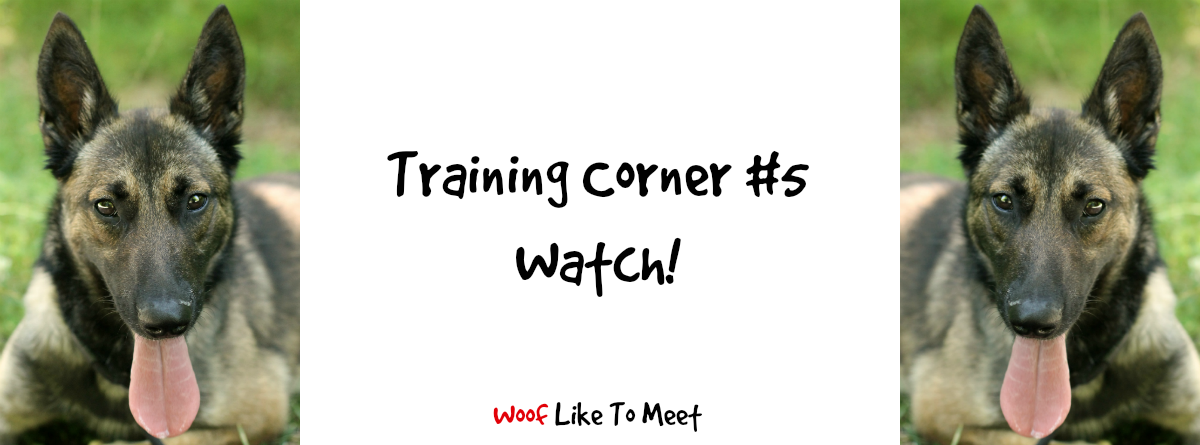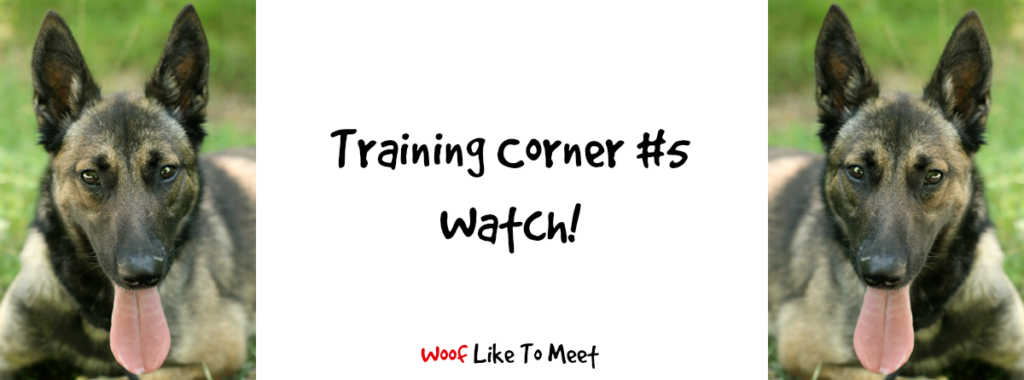One of the ‘non-food’ trainers was complaining about how positively-trained dogs often look at their hands on a thread I was following the other day. I was watching a video of obedience training this morning with a dog who wasn’t paying any attention at all to the handler, only to her hand and treat bag, and in my mind this can be one of the drawbacks of using food or toys. I could really see what that criticism was about. I don’t want a dog who’s constantly looking at my hands or treat bag in the same way as I don’t like having interactions with humans who only stare at my chest.
My eyes are up here, buddy.
That was very true of Hagrid, the mali x GSD, at the shelter. He was already hand-obsessed, due to protection training that had left him obsessed by the movements of hands and arms. Add a little food obsession in there and you’ve got a recipe for lots of focus on hands. My hand going to my pocket was watched with an unhealthy fixation. I taught him “Watch!” early in the sequence of things I taught him because I don’t want a dog’s eyes on my hand. I want them on my face.
But eye contact can also be a tricky one where dog body language is concerned. We all know that a hard stare is offensive TO a dog, and offensive FROM a dog. They don’t like it when we stare at them, and we don’t like it if they stare at us. For nervous Nellies, for humper Harrys, for attention-seeking Amigos, eye contact is about lots more than just ‘look at me’. It’s about being engaged. It’s about being in the moment. It’s about a partnership. It’s about communication. But it can also be frightening or offensive to a dog.
I teach a dog to look at my eyes for lots of reasons. One reason is that people WILL eyeball your dog and you WILL have to get your dog used to that. I had four dogs last year who were reactive to humans who looked at them! If you teach your dog to look at you in a careful and gradual way, it can be part of teaching them that it’s okay for humans to give you a bit of a chimpy gaze from time to time.
That’s important for dogs to learn.
Dogs don’t naturally stare at each other very much. It can be very confrontational.
Effel my beauceron foster used to do this with Heston. If they were lying in beds opposite each other, Effel would stare hard at Heston. Heston would growl and grumble. I’d call Effel’s attention and then he’d dart a hard stare at Heston on the sly! You could easily miss that darted stare and think Heston was being an arse. Seriously, Effel would look back at me like, ‘Will you look at that! He’s growling at me!’ – if dogs did indignant mock outrage, he had that down to a tee. Staring can be part of posturing.
I’m sure many behaviourists and trainers will tell you about dogs who are not reactive until you look at them!
Staring or fixing is also part of the predatory chain for dogs too, which is why I want dogs to be able to watch and release on cue, not only with me but with other things too. They can be animate living things like people or animals, or inanimate moving things like bikes, lawnmowers and cars. Either way, being able to break the predatory stare of a dog is vital to stop that behaviour escalating.
Dogs do stare in different ways with humans though, which is unique to our human-dog bond. Dogs will look to the eyes naturally with humans in ways that they don’t even do with their own species. It is one of the reasons that scientists think the dog-human bond is so special. Eye contact is a reason why they bond with us so well. That stare releases all kinds of positives for both of us, if you read neuroscientist Greg Berns or the work of Brian Hare.
It’s more than bonding or posturing, though. It’s not just about underlying emotions. It can be a learned behaviour – a trick your dog can do.
I teach a dog to look at me because it’s an incompatible behaviour for those environmental distractions, like distant sheep that just look like they might want a dog rampaging through the field, or a car that is in need of rounding up, or a jogger that is obviously running up to us to chase and kill us. A dog who has mastered a hand touch, a recall and a watch is a dog who has three ways to interact with you at vital times, rather than the environment.
So when dog-hating Hagrid was about to cross paths with dog-hating Estas, I U-turned 90° away from Estas, asked for a sit, and a ‘Watch me!’ whilst Estas walked by his handler with a ‘Watch me!’ on the other. How you get two dog-aggressive dogs past each other on a two metre wide path without any conflict whatsoever. No posturing, no freeze, no hard stare, no growling, no lunges, no air-snapping.
“Watch!” is one way to create a bubble around you and your dog, in which the environment around you doesn’t matter.
That’s why “Watch!” or any of its synonymous cues is part of the majority of reactive dog programmes.
But before you start teaching it as a trick, be aware of your dog’s personality. My Amigo hates a hard stare from me. So does Tilly. Heston was mine from a pup and I taught him ‘Watch’ as the second thing he learned, so he was never a problem. Lidy at the shelter is nervous of stares, so I started with her looking at my face and me looking at her nose. Then I used very soft eyes and very short looks. Not all dogs are like this though. Hagrid at the shelter loves a full-on shepherd stare. Gazing into each other’s eyes has been shown to raise levels of oxytocin, the bonding hormone, and it’s not unusual for a dog to gaze at you and do a big sigh. That’s not why Hagrid does it. He does it because he knows a treat comes next and if he looks at my hands, he won’t get it. Some dogs are going to stare at you as well as a way to get your attention. Having it on cue can stop that behaviour spilling out all the time when you don’t want it. Know your dog, start with short durations if necessary and build up duration.
If you do obedience or rally, or many other types of dog competition, a “watch!” will also be essential.
So… vital for avoiding hand obsessions, avoiding distractions, for relationships, for desensitising a puppy to human behaviours, for competitions… a good all-rounder.
I don’t actually use the word “Watch” as it’s similar to a number of other words in sound, like “touch” and “fetch”, but many people use these words without a problem. The W sound at the beginning is different enough not to cause much confusion. I use the words “eyes” because it is unlike any other word in my cue vocabulary. Some people call it “Look at me!” (which I teach as a different behaviour later, specifically around distration, when I don’t care where they look as long as it’s around my person) and some people say “Watch me!”
The important thing is that you have a word or very short phrase that works for you and that you stick to that word.
You can teach this behaviour in a number of ways. You’re going to start in a really easy location with no distractions. You need to be close to your dog too.
The first is with a lure.
That means you get a piece of food or a toy, and you show it to the dog. You bring it up to your eyes. When they’re looking in the right area, you click or say “yes!” and then you give them the food. If you do this five times or so, and then fake them out – pretend you have something in your hand, bring your hand up to your face, mark the behaviour with your click or “yes!” and then give a treat really quickly from your other hand. After a few repetitions and practices, you can start putting the cue, “Watch me!” in there.
The second way you can teach ‘Watch!’ is by capturing behaviour. You can see Emily Larlham doing it here:
Another way you can do it is to drop a treat on the floor and then wait for the dog to look up at you before you mark the behaviour with a “yes!” or a click and then drop another on the floor.
You can also see Donna Hill doing this here, capturing behaviour without a lure
Watch is such a great way to make sure your dog is focused on your face, and it’s also a great one for managing difficult or distracting environments. As usual, start simple and short in a safe and quiet environment, building up duration and challenge in a wider range of situations. When you’ve got a failsafe “Watch!” in many situations, you can use it easily to manage temporary distractions that you don’t want your dog to see. If you have a sight-hound, a collie or a shepherd, that’s going to be really useful! It also teaches your dog to look to you so that you can ask for another behaviour. It’s a foundation before ‘an auto check-in’, which can also be a very useful skill.
So get out there and practise your “Watch!” cue. Start easy with minimal distance in a distraction-free environment, and advance it from there. When you’ve got a mighty fine “Watch!” your predatory dog will let all manner of distractions go by, your reactive dog will care more about you than barking at the other dog, and your hand-obsessed greedy golden retriever will be looking at the eyes, not the hands.


